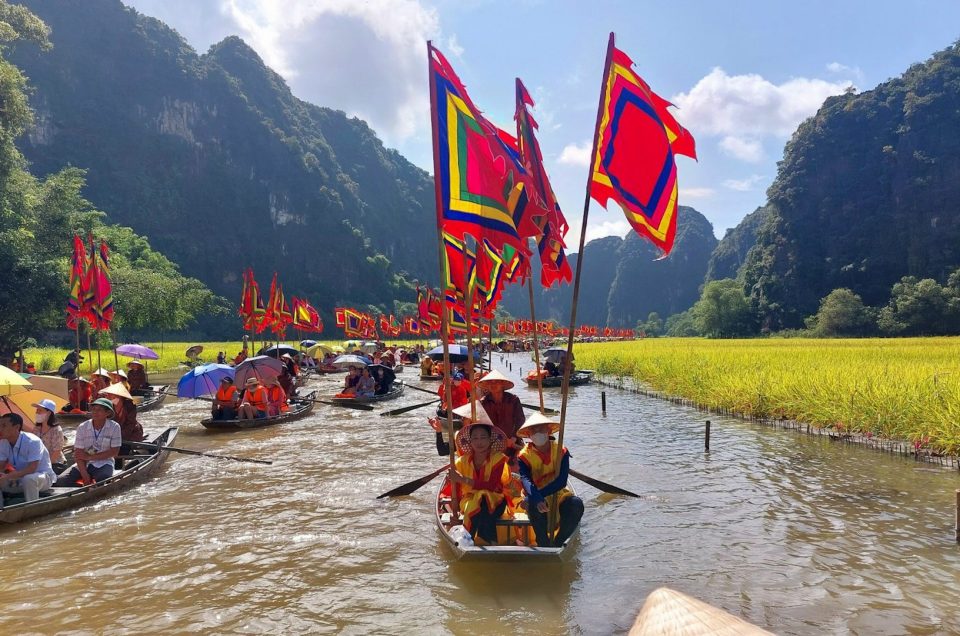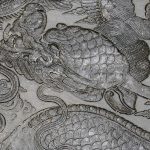Golden Tam Coc
The Trang An Scenic Landscape Complex boasts a system of limestone mountains with karst terrain interspersed with a rich ecosystem of forests, caves, and marshes. Over hundreds of millions of years, the tectonic process has created a surreal and unique landscape in this region.

Trang An is home to 31 lakes and ponds and 48 caves, with a variety of underwater flora and fauna, along with thousands of species of algae and moss. Within the Trang An Scenic Landscape Complex, Tam Coc – Bich Dong is an impressive destination, beloved by domestic and international tourists. Tam Coc – Bich Dong covers more than 350 hectares, located in Ninh Hai commune (Hoa Lu district). “Tam Coc” means three caves, consisting of Ca Cave, Hai Cave, and Ba Cave, connected by the Ngo Dong River, which flows through the mountains. Bich Dong, located 2km from Tam Coc Wharf, includes a dry cave halfway up the mountain (where Bich Dong Pagoda is located) and a water cave within the mountain (Xuyen Thuy Cave). Along with its significant geological value, Tam Coc – Bich Dong is an ancient land with a meaningful history and many legends. According to historical records, from the 13th century, kings of the Tran Dynasty trained their soldiers in this treacherous terrain. They established Vu Lam Palace, achieving victory in the second resistance war against the Yuan Mongols. According to legend, it was here that King Tran Nhan Tong renounced his throne to become a monk, before later ascending to Yen Tu Mountain to establish the Truc Lam Zen sect. Visitors to the Trang An Scenic Landscape Complex are astonished by the surreal beauty of the mountain scenery and feel the sanctity of each historical relic that has withstood the test of time.

Tam Coc – Bich Dong is beautiful in every season, but especially impressive and poetic during the summer when the green rice fields gradually turn a shimmering golden hue. After being nourished, from late May to early June, the rice fields in Tam Coc begin to bloom heavily. The ripe rice fields resemble a .golden carpet stretching along the winding river. Unlike in other places, the rice fields in Tam Coc grow amidst ancient limestone mountains beside the gentle flow of the Ngo Dong River. As they relax in a wooden boat, visitors feel as if they have entered a fairyland, listening to the leisurely sounds of the oars stirring the water and watching the shadows of towering mountains reflected on the still water. The fragrant rice fields spread their aroma in the breeze, the vegetation on both riverbanks rustles, and the mountains stand majestically, covered in lush greenery. The boat slowly parts the water, passing through caves where visitors can admire miraculous stalactites that form strange and fascinating shapes. Ca Cave and Mua Cave are ideal spots for panoramic views, where tourists can fully embrace the golden beauty of Tam Coc. From above, the harmony of nature unfolds in a breathtaking landscape. Below, lines of boats glide on the tranquil river. During the harvest season, farmers busily reap rice and load it onto boats. Laughter and chatter fill the river and echo from the mountains. One can sense the joy in each mound of rice piled high on the boats carrying the season’s golden yield. If you visit during the festival that is held annually when the rice ripens, you can participate in Ninh Binh Tourism Week, which has the theme: “The Golden Color of Tam Coc – Trang An”.

Beyond admiring the fresh golden hues of the rice fields and the pink of lotus flowers in the summer, visitors can also enjoy the red of Bombax ceiba flowers at the end of spring. As clusters of scarlet Bombax ceiba flowers set the sky ablaze, the Trang An Festival takes place, featuring a series of unique cultural and tourism activities. The festival aims to express people’s reverence for their ancestors who contributed to exploring, settling, and protecting this region. The festival honors the mountain gods of the four guardian directions of Hoa Lu district, the early Tran Dynasty kings who established Vu Lam Palace, and the Dinh Dynasty generals stationed in Trang An. The ceremonial part of the festival includes many solemn rituals, notably a water procession, palanquin procession, and dragon dances on the river. The festive part is equally colorful, with performances of Cheo singing and Xam singing on boats and various folk games for locals and tourists to enjoy.





